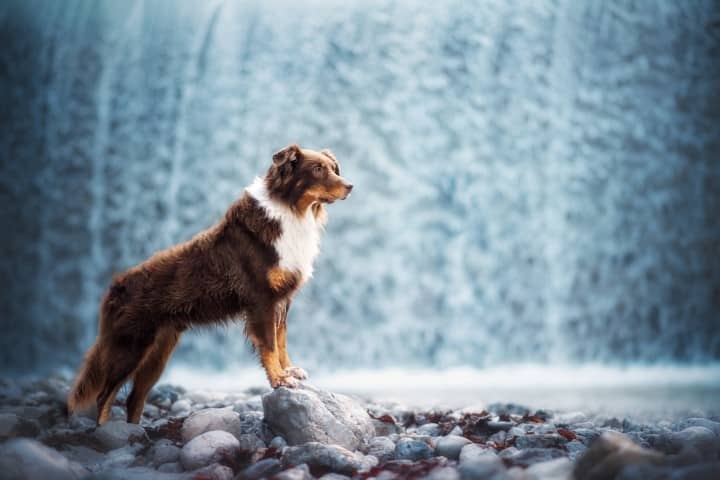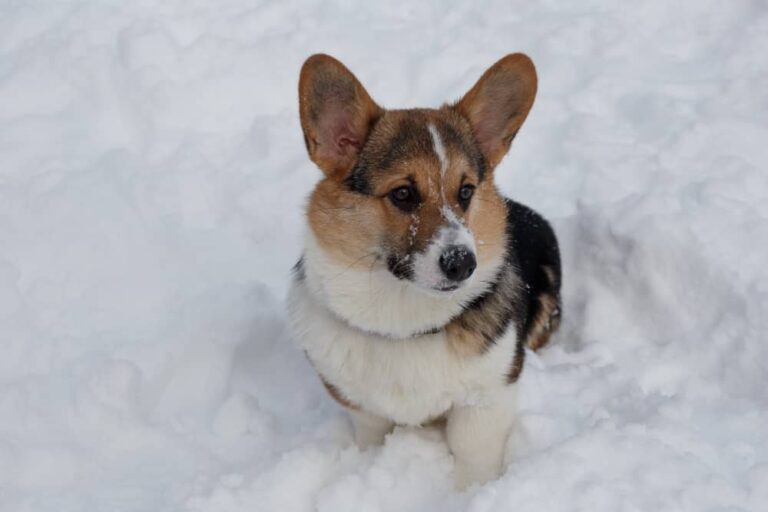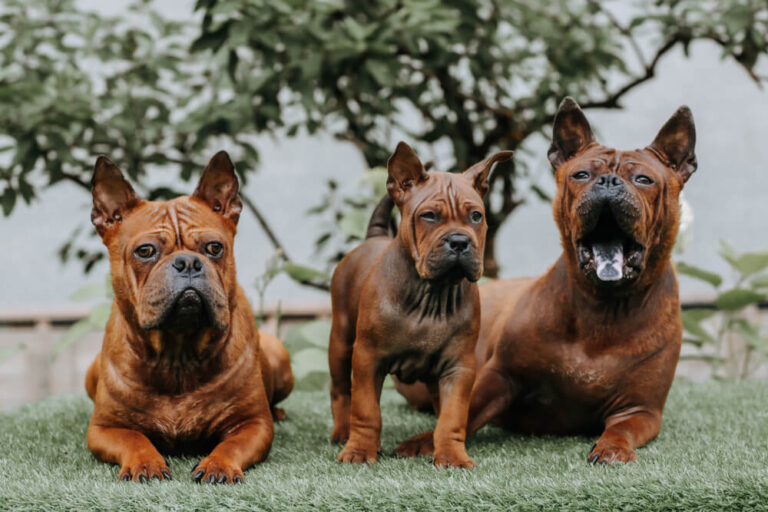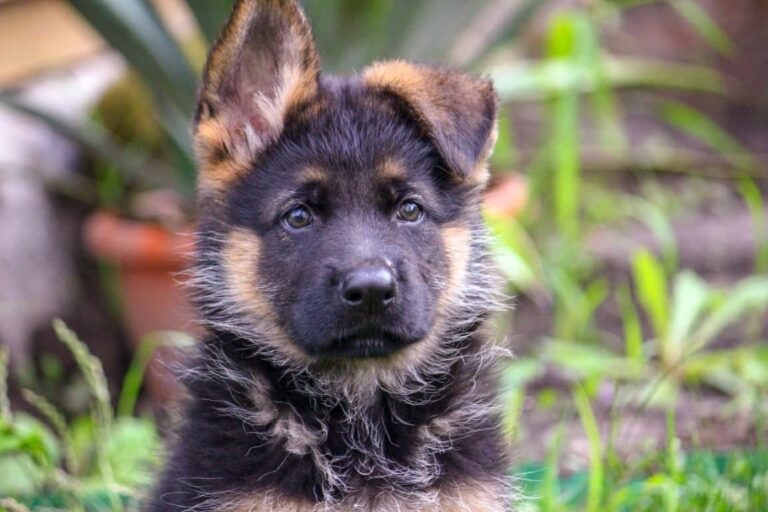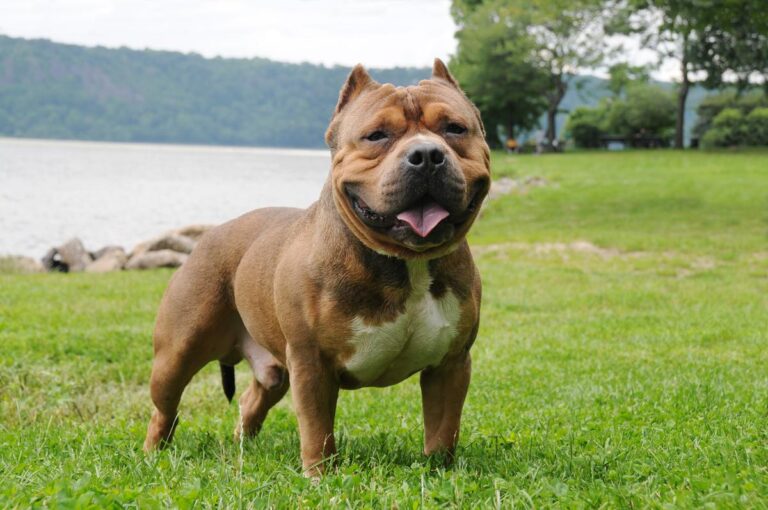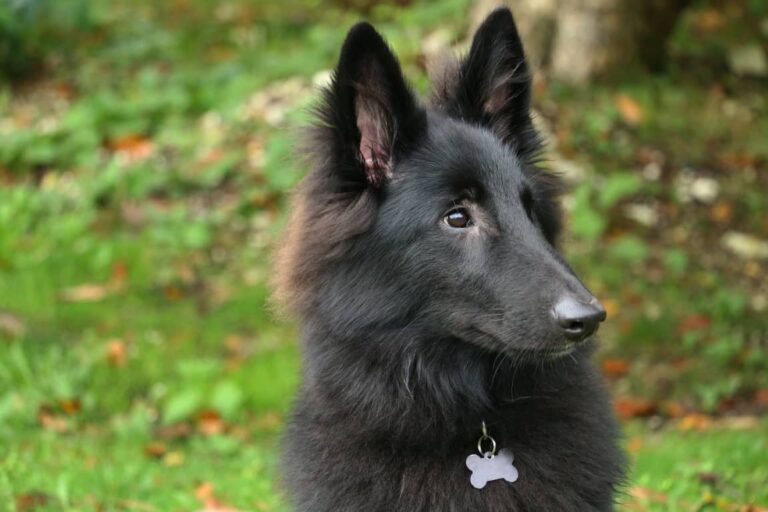Conquering Curiosity: Merle Great Dane Explored
Few dogs have as much appeal and enchantment in the fascinating world of canine coat colors as the Merle Great Dane. Merle Great Danes have won the hearts of dog lovers all over the world with their eye-catching patterns and captivating colors. But what does this gorgeous coat color hide underneath?
How did this gorgeous breed’s colors develop, and what genetic problems provide such an aesthetically stunning appearance? What can we learn about these gentle giants’ personalities and characteristics beyond their alluring appearance?
In this article, we set out on an adventure to discover the mysteries and attractions of the Merle Great Dane, looking into everything from the fascinating genetics that determine their coat color to the distinctive personality that makes them stand out.
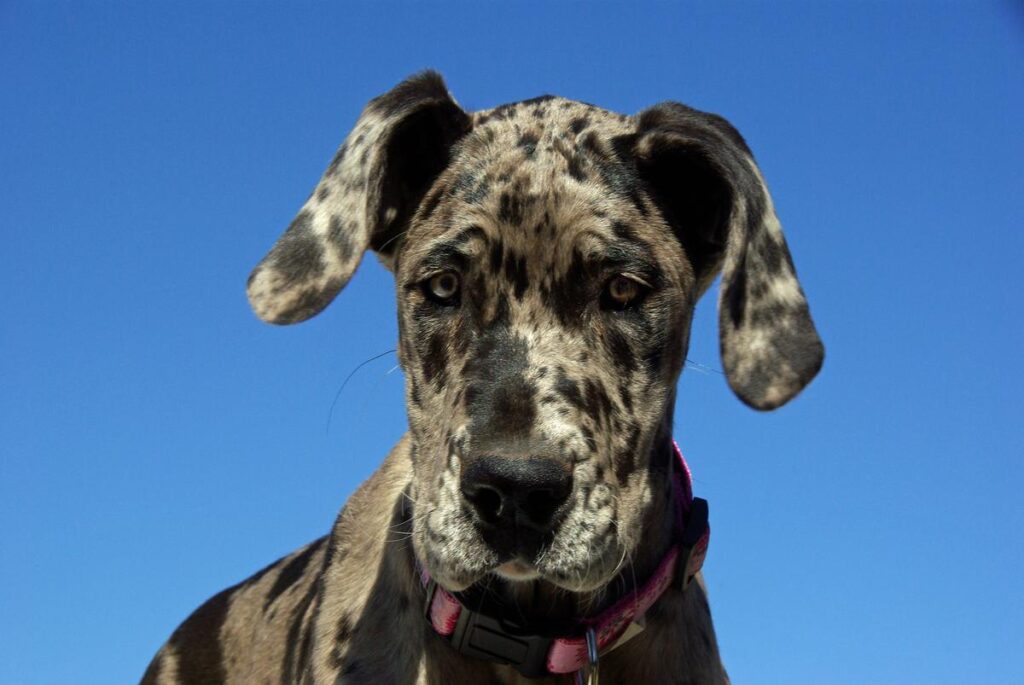
Whether you’re a die-hard Merle fan or just fascinated by the genetic and behavioral mysteries of dogs, this thorough guide will take you on a fascinating review of these captivating creatures.
What exactly is a Merle Great Dane?
A Merle Great Dane is a unique pattern brought on by a particular gene. The Merle gene is a dominant gene, which means that only one parent needs to pass it on for a child to have it. There is no need to breed two carriers together because this can only be passed on by a single parent.
On the Great Dane, patches of darker fur that are part of the Merle pattern can be seen. Due to the pattern being distinct and varied on each dog, this is frequently referred to as a marbled effect. Although this is not a strict rule, there are typically some similarities, such as smaller spots around the face and larger patches on the torso.
Merle puppies can be produced from any Merle dog because Merle is a dominant gene. There is a fifty percent chance of getting Merle offspring when breeding a Merle dog with any Non-Merle. It would be tempting to breed two Merles together if you were hoping to generate Merle dogs. However, there are medical reasons why this should not be done.
Dogs having two copies of the Merle gene can develop serious health problems. Because these are known as Double Merles, you should never breed two Merles together. Having two Merle parents increases the likelihood of a puppy being a double Merle by about 25%. A DNA test should be done if you plan to breed your dog but are not sure if it has the Merle gene.
How uncommon are Merle Great Danes?
Although each Merle Great Dane has a distinctive color pattern, they are not a particularly rare breed. However, it is noteworthy to remember that breeders once attempted to eradicate the merle gene because of the risks to health that it poses.
Remember that some breeders still insist that merles are more rare than they are, largely so they can charge more for them. Just because a dog is colored a certain way doesn’t mean you have to spend more money.
Similarly, before selecting their breeder, people who want their merle to participate in shows should become familiar with the requirements of the Great Dane Club of America Breeder’s Code of Ethics.
The History of Merle Great Danes’ Earliest Records
According to history, the Great Dane’s origins date back to the fourteenth century. However, there are drawings from ancient that remarkably like this kind of dog. According to historical documents, this breed was developed in Germany and Great Britain to aid in the management of wild boar populations.
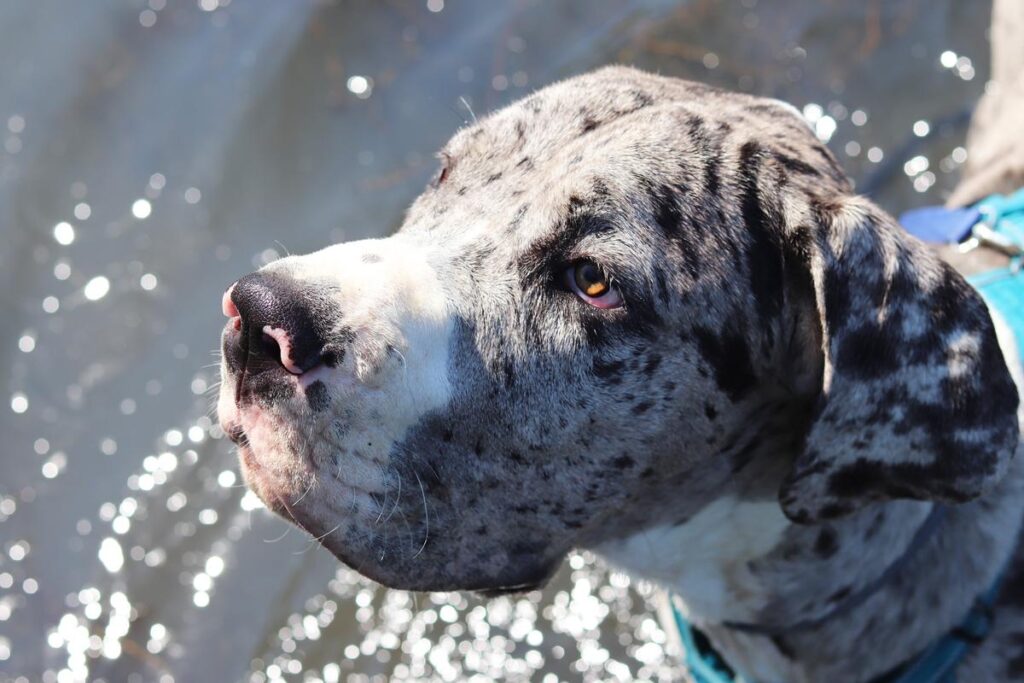
Breeders combined the speed of the Greyhound and the power of the English Mastiff to produce a dog breed that was powerful and quick enough to handle the problem. Many people think that breeders might have included the Irish Wolfhound in the mix as well.
The resulting dog breed was suitable for the intended use whether or not the Irish Wolfhound was included in the mix. The Great Dane was strong, quick, and hardy enough to fight off the local wild boars without getting hurt by them.
One of the seven Great Dane color variations is the Merle Great Dane. This variance was observed in the early years of the breed’s history. The Merle Great Dane is a popular variant nowadays. The Great Dane, with all of its color variations, was imported to the United States in the 1800s, according to history.
Overview of the Merle Great Dane breed
| Characteristic | Description |
|---|---|
| Breed | Great Dane (Merle Coat) |
| Life Span | 7 – 10 years |
| Price Range | $800 – $3,000+ (Varies based on pedigree, color, and breeder reputation) |
| Health Considerations | Great Danes can be prone to certain health issues like bloat, hip dysplasia, heart problems, and certain cancers. Regular veterinary care and a proper diet are essential. |
| Exercise Needs | Moderate exercise; daily walks and playtime. While Great Danes are large, they are gentle giants and don’t need extremely rigorous exercise routines. |
| Temperament | Typically friendly, patient, and gentle. Great Danes are known for their affectionate and calm nature. |
| Size | Large breed; males typically weigh 140-175 lbs (63-79 kg) and stand 30-34 inches (76-86 cm) tall at the shoulder. Females are generally smaller. |
| Coat Type | Short coat, smooth and dense. Merle coat patterns can include a mix of colors, often with a marbled or mottled appearance. |
| Grooming Needs | Minimal grooming required. Regular brushing and occasional baths are sufficient to keep their coat healthy. |
| Training | Intelligent and trainable, but early socialization and positive reinforcement training are important due to their size. |
| Living Space | Great Danes can adapt to apartment living, but due to their size, a spacious environment with access to a yard is ideal. |
What Made Merle Great Danes Popular?
Merle Due to their strength against wild boars, Great Danes gained popularity in Germany and England almost immediately. The Great Dane population in both countries was growing quickly by the 1600s, and German nobility was keeping the biggest and best among them.
As many Great Danes were being murdered while hunting wild boars, the Merle and other colors of the breed began to change from being violent hunting dogs to becoming human friends and guardians, which was much healthier for their longevity.
Read More: Enchanting Lilac Pitbull: A Rare Beauty Among Canines
Just because a dog is colored a certain way doesn’t mean you have to spend more money. Similarly, before selecting their breeder, people who want their merle to participate in shows should become familiar with the requirements of the Great Dane Club of America Breeder’s Code of Ethics.
How does Merle look?
As opposed to all other Great Dane coat colors and color patterns, the term “merle” refers to a coat color pattern that is unique. But even within the merle color pattern itself, it can still result in a lot of perplexing variances.
To determine which merle color pattern most closely resembles your Great Dane puppy, consult the Great Dane Illustrated Breed Standard. A light to dark grey background with black patches makes up the Merle coat color pattern.
Why Merle Great Danes Became So Popular
Due to its prowess against wild boar in the 1600s, the Great Dane became immediately famous. However, the Merle coloration was also a well-liked option. But these strong dogs were particularly beloved by the German noblemen.
At this point, the transformation from a capable hunting dog to a cherished pet started. They were regarded as excellent friends and watchdogs for the local populace. Germans began the first clubs to recognize the Great Dane because they loved the breed, even if they gave it the moniker Deutsche Dogge.

The appearance of the Merle Great Dane
There are numerous coat colors for Great Danes in which the merle pattern can be seen.
Some patterns, such as mantle and merle or brindle and merle, can also blend.
This opens up a wide range of options for Merle Danes’ coats.
To view some of the typical variants, look below!
Characteristics of a Great Dane with a Merle coat
| Appearance Characteristic | Description |
|---|---|
| Coat Color | Merle coat patterns with a mix of colors, often including a marbled or mottled appearance. The base color can vary. |
| Size | Large breed; males typically weigh 140-175 lbs (63-79 kg) and stand 30-34 inches (76-86 cm) tall at the shoulder. Females are generally smaller. |
| Body Structure | Sturdy and well-muscled body with a deep chest and strong legs. The body is long, and they have a regal and dignified stance. |
| Head | Proportionate to the body, with a square-shaped muzzle. The head is expressive and has a distinctive appearance. |
| Ears | Medium-sized, set high on the head. They can be cropped or left natural, depending on owner preference and regulations. |
| Eyes | Dark, expressive eyes that convey a gentle and friendly expression. |
| Tail | Long, tapering tail that reaches down to the hocks. It’s carried low and is usually straight. |
| Gait | Smooth and powerful gait with an effortless stride. Great Danes move gracefully despite their size. |
| Overall Impression | A majestic and elegant breed with a noble demeanor. Their unique coat patterns add to their striking appearance. |
- Solid Merle Great Dane
Typically, this describes Great Danes with coats that are light/dark gray with black patches scattered throughout.
- Merle Mantle Great Dane
This is comparable to the one above, but it also incorporates the mantle pattern.
White patches are added to the coat by the mantle, mainly on the chest, legs, and muzzle.
- Blue Merle Great Dane
A diluted blue coat has this merle pattern on it.
- Blue Merle mantle Great Dane
combination of the three things.
- Brindle Merle Great Dane
A merle and brindle design mixed.
These Great Danes will have merle spots and black stripes on a golden background.
- Brindle Merle Mantle Great Dane
A blending of these three designs.
Stripes, merle patches, and white areas.
- Blue brindle Merle Great Dane
Coat in yellow and gold with merle patches and blue stripes.
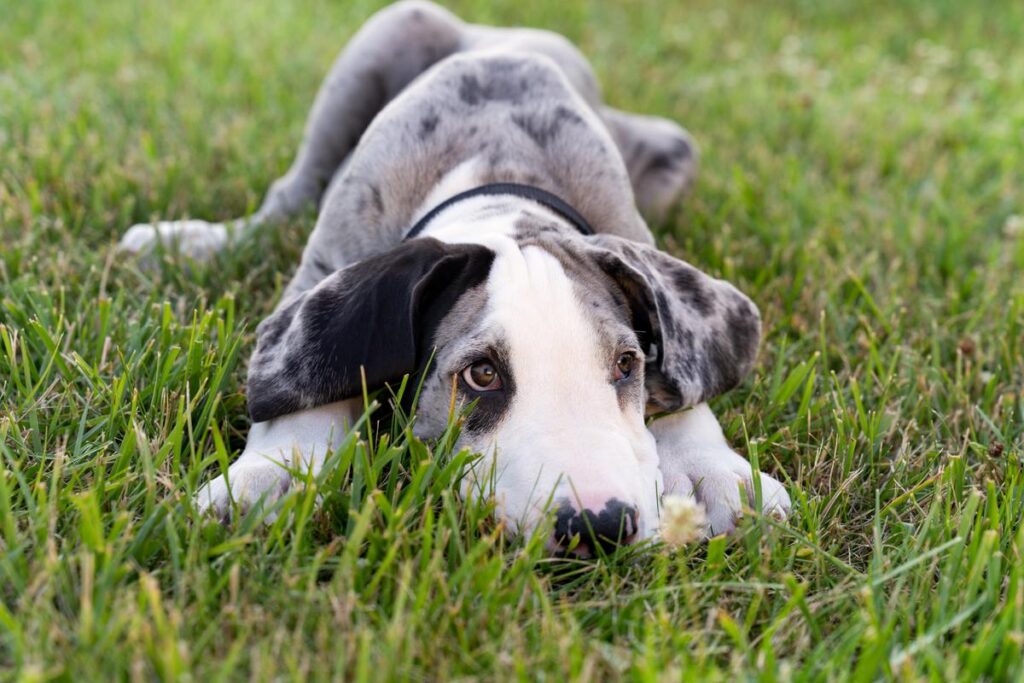
- Blue Brindle Merle Mantle Great Dane
Same as above, but with white patches on the mantle.
- Fawn Merle Great Dane
Coat made of solid yellow gold with merle patches.
- Fawn Mantle Merle Great Dane
Same as the above, but with white mantle patterning.
- Blue Fawn Merle Merle Great Dane
The Fawn Merle is the same, but the Merle patches are much lighter.
- Blue Fawn Mantle Merle Great Dane
A combination of beautiful hues and patterns.
There are Great Danes that are blue merle, silver merle, and chocolate merle, among other standard colors that are listed by the AKC.
The harlequin merle Great Dane is another fairly unique case.
A gene that functions as a modifier to the Merle gene is referred known as a harlequin.
A white Great Dane with black dots and merle patches results if both are present.
Two harlequin dogs may crossbreed to produce a variant of the Great Dane breed known as the Harlequin Great Dane.
Nearly all of these dogs’ coats will be white, with a few minor black spots.
Merlequins, however, should not be bred because of the extremely high risk of health issues associated with their coats.
There won’t be any physical distinctions between a Merle Great Dane and a non-merle Great Dane regardless of the Merle Great Dane you choose.
The coat’s pattern will be the only thing that differs.
Food and Dietary Requirements
- Banana: Dogs can enjoy the natural sweetness and health benefits of bananas in moderation.
- Asparagus: A nutritious veggie that can be a crunchy and tasty treat for your furry friend.
- Strawberry: Rich in vitamins, strawberries make a delightful occasional snack for dogs.
- Orange Chicken: Plain cooked chicken without spices or sauces can be a safe protein source for dogs.
- Almond Butter: Avoid almonds, but dogs can indulge in unsalted and unsweetened almond butter as an occasional treat.
- Quesadilla: Plain tortilla with a small amount of cheese can be a simple treat for dogs.
- Pita Bread: A small piece of plain pita bread can be given as an occasional snack.
- Ricotta Cheese: Dogs may enjoy a little ricotta cheese as an occasional treat, but avoid excessive amounts.
- Provolone Cheese: Offer a tiny piece of provolone cheese as a special reward for your furry companion.
- Banana Pudding: Plain banana pudding without additives or artificial sweeteners can be an occasional treat.
- Watermelon: A refreshing and hydrating fruit that dogs can enjoy in small, seedless portions.
- Coffee Chew Wood: Coffee and any type of wood should be kept away from dogs, as they are harmful.
- Oatmeal Cream Pie: Avoid sugary snacks like oatmeal cream pies, as they are not suitable for dogs.
- Teriyaki Sauce: Skip the teriyaki sauce, as the high sodium content is unhealthy for dogs.
- Mushroom Cream Soup: Keep creamy soups, especially those with mushrooms, away from your furry friend.
Vitamins and Nutritional Pros and Cons
- Banana:
- Vitamin B6:
- Pros: Supports metabolism, immune system, and red blood cell production.
- Cons: Overconsumption may cause gastrointestinal upset due to high fiber content.
- Vitamin C:
- Pros: Acts as an antioxidant, boosts the immune system, and promotes healthy skin.
- Cons: Dogs produce their own vitamin C, so supplementation is usually unnecessary.
- Vitamin B6:
- Asparagus:
- Vitamin A:
- Pros: Essential for vision, immune function, and cell growth.
- Cons: High-fiber content may lead to stomach upset if given in large quantities.
- Vitamin C:
- Pros: Supports the immune system and helps absorb iron.
- Cons: Overfeeding may lead to gas or mild digestive issues.
- Vitamin A:
- Strawberry:
- Vitamin C:
- Pros: Provides a boost to the immune system and has antioxidant properties.
- Cons: Should be given in moderation due to natural sugars.
- Vitamin C:
- Orange Chicken:
- Vitamin B6:
- Pros: Supports metabolism and brain health.
- Cons: Avoid giving chicken with spices or sauces, which can be harmful.
- Vitamin B6:
- Almond Butter:
- Vitamin E:
- Pros: Protects cells from damage and promotes healthy skin and coat.
- Cons: Almonds themselves can be a choking hazard, so avoid direct consumption.
- Vitamin E:
- Quesadilla:
- Vitamin B6:
- Pros: Supports energy metabolism and nervous system function.
- Cons: High-fat content in cheese may lead to weight gain if given excessively.
- Vitamin B6:
- Pita Bread:
- Various B Vitamins:
- Pros: Essential for energy metabolism and nerve function.
- Cons: Pita bread can be high in carbohydrates, so feed in moderation.
- Various B Vitamins:
- Ricotta Cheese:
- Vitamin A:
- Pros: Important for vision and immune system support.
- Cons: High-fat content, so feed in small amounts to avoid weight gain.
- Vitamin B12:
- Pros: Supports nerve function and red blood cell production.
- Cons: Excessive consumption may lead to gastrointestinal upset.
- Vitamin D:
- Pros: Aids calcium absorption and supports bone health.
- Cons: Over-supplementation can lead to toxicity, as dogs can’t regulate vitamin D as effectively as humans.
- Vitamin K:
- Pros: Crucial for blood clotting and bone health.
- Cons: Excessive vitamin K can interfere with blood-thinning medications.
- Calcium:
- Pros: Essential for bone and teeth health, muscle function, and nerve transmission.
- Cons: Over-supplementation can lead to skeletal problems and urinary issues.
- Vitamin A:
- Provolone Cheese:
- Vitamin A, Vitamin B12, Vitamin K, Calcium:
- Pros: Similar to ricotta cheese, these vitamins and minerals offer various health benefits.
- Cons: High-fat and sodium content, so feed in moderation to avoid health issues.
- Vitamin A, Vitamin B12, Vitamin K, Calcium:
- Banana Pudding:
- Vitamin B6:
- Pros: Supports metabolism and various body functions.
- Cons: Pudding may contain added sugars and artificial ingredients, which are not suitable for dogs.
- Vitamin B6:
- Watermelon:
- Vitamin A, Vitamin B6, Vitamin C:
- Pros: Provide essential vitamins and hydration.
- Cons: Remove seeds and feed seedless watermelon in small portions to prevent choking.
- Vitamin A, Vitamin B6, Vitamin C:
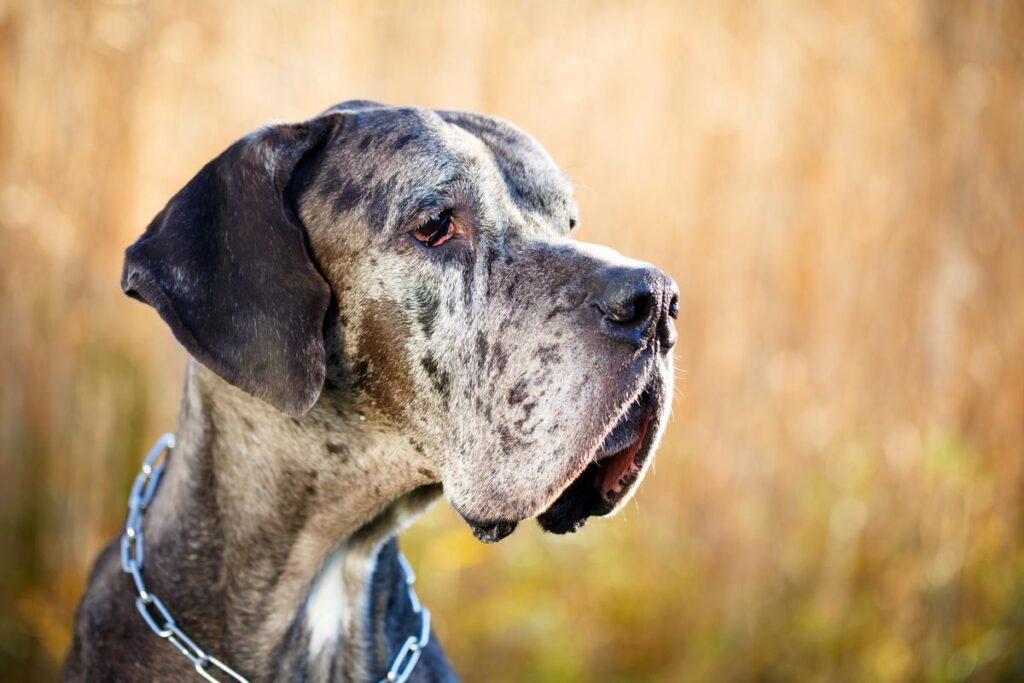
Health Problems in Great Danes
Like most dogs, Great Danes can experience a variety of health problems, many of which are brought on by their great size. We list a few of the more prevalent diseases below. In addition to the Merle Health Issues, these exist.
- Dysplastic Hips
As a result, the hind legs have a smaller range of motion and are reluctant to jump, run, or climb stairs. Maintaining a healthy weight and feeding them nutritious food will help delay the onset.
- (GDV) Gastric Dilation Volvulus
The main cause of this is eating fewer, larger meals throughout the day. According to studies, dogs who only have one major meal per day are more prone to develop the condition. Additionally, it has been noted that diets high in oils, like sunflower or animal fat, may play a role.
There are further strategies to lower the danger, even though this condition can be fatal in the worst-case scenarios. In addition to eating multiple times a day, elevated feeding is advised as a technique to lower this pressure.
- Allergies
Like the majority of dog breeds, Great Danes might be allergic to certain things. This commonly shows up as red or raw patches, frequently around the paws. Additionally, it may manifest as sneezing, watery eyes, or ear infections. It is best to talk with a veterinarian about potential remedies if you suspect allergy problems.
- Heart Disorder
The best strategy to lower the risk of heart disease in Great Danes is through breeding. The parents of any puppies should have their medical histories disclosed since this will be the best predictor of risk.
Gut Guard – For Dogs with Irritated Guts
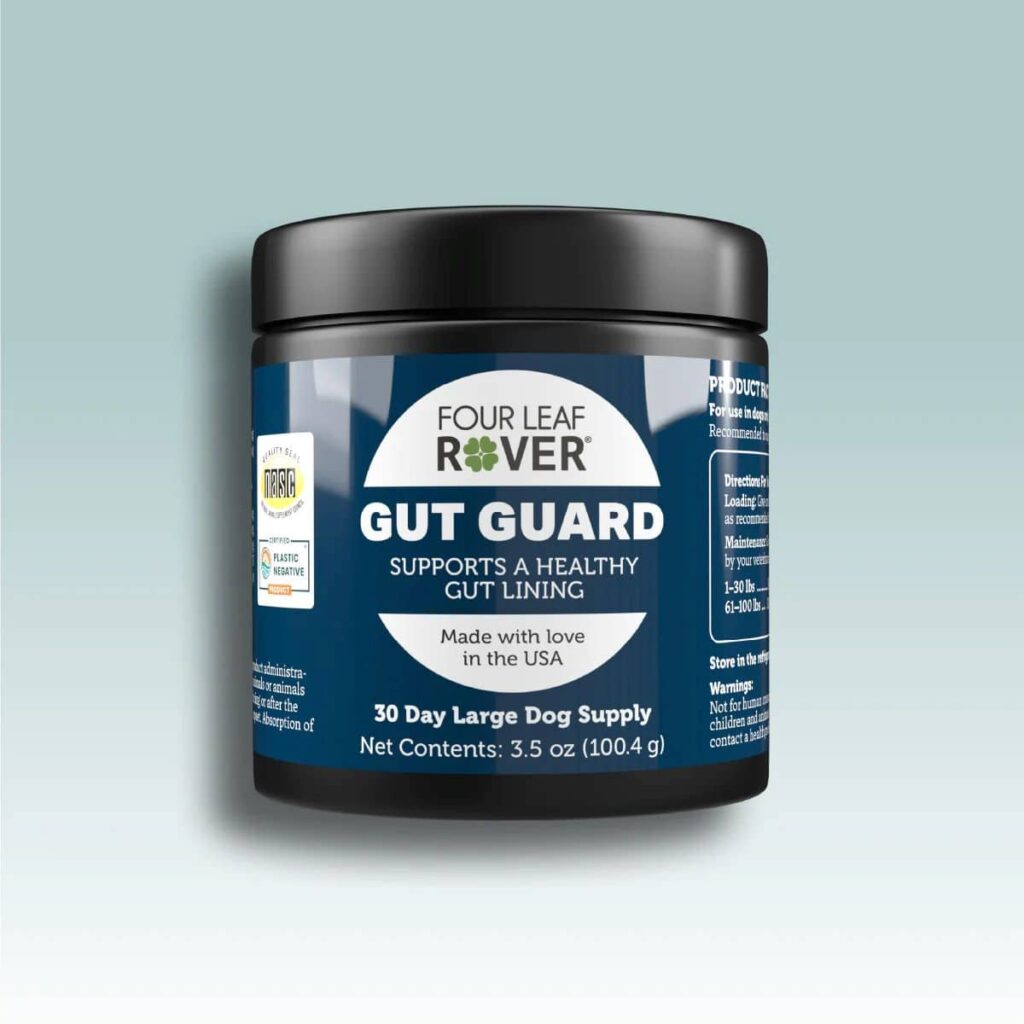
- Gut Guard: A veterinary formulated blend of probiotics and herbs designed to support a normal inflammatory response in the gut and immune system of dogs.
- Supports Gut Health: Many foods, toxins, chemicals, and drugs have the potential to damage the gut lining, making it more permeable, leading to digestive issues.
- Prevents Toxin Leakage: By promoting a healthy gut lining, Gut Guard helps prevent toxins from escaping the gut, reducing the risk of health and immune issues in dogs.
- Combination of Probiotics and Herbs: The unique blend of probiotics and herbs in Gut Guard work synergistically to support gut health and immune function.
- Veterinary Formulated: Developed by veterinary experts to ensure the best possible support for canine digestive and immune systems.
| Size Characteristic | Male Great Dane | Female Great Dane |
|---|---|---|
| Height at Shoulder | 30-34 inches (76-86 cm) | 28-32 inches (71-81 cm) |
| Weight | 140-175 lbs (63-79 kg) | 110-140 lbs (50-63 kg) |
| Body Length | Long and proportionate body | Long and proportionate body |
| Overall Stature | Impressively large and strong | Impressive, slightly smaller |
| Growth Rate | Rapid growth during puppyhood | Rapid growth during puppyhood |
Read More: Dominate the Cute Factor: Teddy Bear Cut for Yorkies!
Size of Merle Great Danes
One of the biggest dog breeds is the Great Dane, and Merle Great Danes are no different. In general, males weigh 120 to 200 pounds, while females average 100 to 180 pounds.
Typical size characteristics of a Great Dane
Men normally measure 30-34 inches tall at the shoulder, whereas women are typically between 28 and 32 inches tall. So, as you can see, there is a wide variety in size for this type of dog.
One of the biggest dog breeds is the Great Dane, and Merle Great Danes are no different. In general, males weigh 120 to 200 pounds, while females average 100 to 180 pounds.
Men normally measure 30-34 inches tall at the shoulder, whereas women are typically between 28 and 32 inches tall. So, as you can see, there is a wide variety in size for this type of dog.
The fact that Merle Great Danes are all large dogs cannot be denied, though. They are not the kind of pet that is appropriate for everyone, so prospective owners should be ready to give them lots of room to play and run around in.
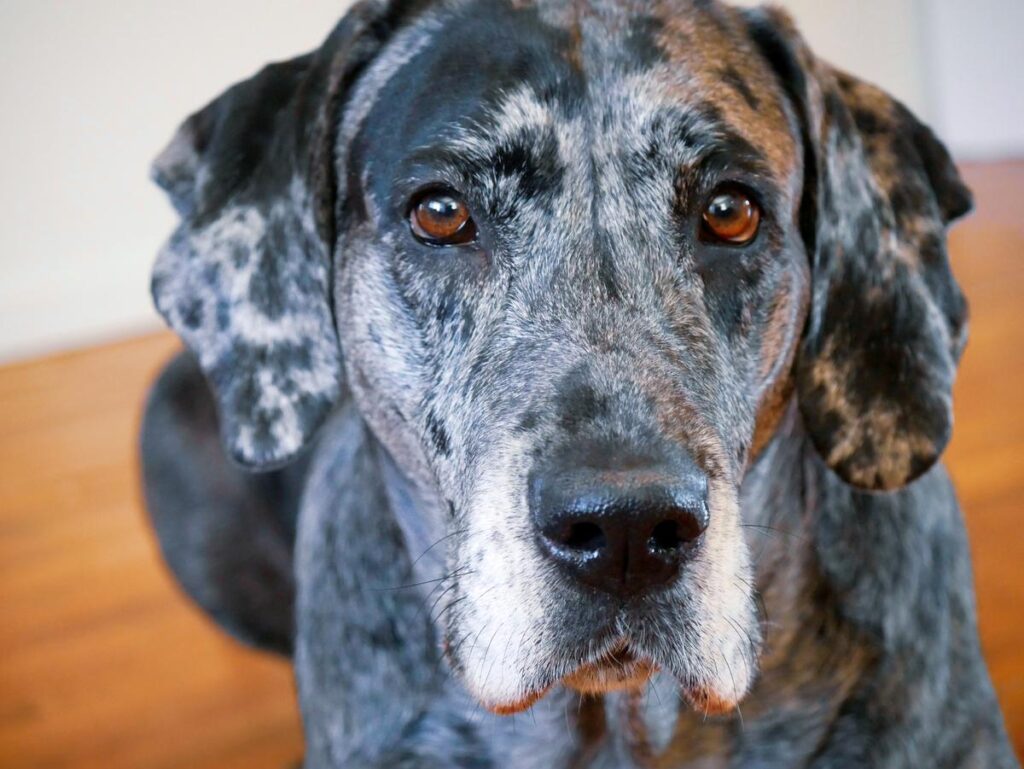
Conclusion
The Great Dane with the Merle coat is a stunning canine. They have a lengthy history and are best recognized for their size and might as one of the many color variations of Great Danes.
This dog breed is for you if you have room in your home and a soft spot in your heart for gentle giants. Even though they take up most of the couch space when it’s time to cuddle, Merle’s terrific Danes are a terrific addition to any family.
While we continue to be fascinated with this fascinating coat color, it is important to keep in mind that a dog’s personality and temperament are not only based on how it looks. Like all dogs, Merle Great Danes are individuals with special traits and characteristics.
We can appreciate these endearing canines while also guaranteeing their happiness and longevity through responsible breeding and care by having an understanding of the genetics and personality features linked with the Merle coat color.
FAQ’S
Q: Are merle great danes healthy?
A: The Merle Great Danes’ unique problems arise when two dogs with the Merle gene breed have a litter. Two common health problems in Merle Great Danes are blindness and hearing. In particular, White Great Danes exhibit them.
Q: Can you breed a merle great dane?
A: Yes, however, to reduce health risks and potential genetic problems, appropriate breeding techniques are needed.
Q; Can you breed Merle and Harlequin Great Danes?
A: It is not advised to breed Merle and Harlequin Danes together owing to possible genetic issues.
Q: Can you breed a Merle great dane with a harlequin?
A: Due to potential genetic and health risks, breeding Merle and Harlequin Danes together is generally discouraged.
Q: How much is a merle great dane puppy?
A: Speaking of coat colors that can affect pricing, a Harlequin Great Dane’s price may be around $2000 due to the color’s uniqueness. On the other hand, because they are not as uncommon, a blue or Merle Great Dane might cost up to $1500. The typical price for more popular colors like white and black can reach $1000.
